……………………………………………………… (Open Star Cluster)
CONTENTS
HOW DID THE SATURN SYSTEM ALIGNMENT OCCUR?
OPEN CLUSTER V. GLOBULAR CLUSTER
HOW DID THE SATURN SYSTEM ALIGNMENT OCCUR?
See CC on Star Formation. — See Saturn Theory. — I had thought that Charles Chandler's model where stars and planets form in an imploding line (interstellar filament) might best explain the ancient Saturn System linear alignment. But Perplexity.ai is telling me that Giant Molecular Clouds form Open Star Clusters instead of individual stars. The stars eventually disperse from the clusters. The SL9 fragments formed a train after encountering Jupiter, so maybe the Saturn Train encountered a star in its home open star cluster that accelerated them out of the cluster in a line, similarly, maybe as rogue planets.
GIANT MOLECULAR CLOUDS
Ly=lightyear/s. Giant Molecular Clouds (GMCs) are primarily located in the galactic disk, particularly in the spiral arms of galaxies like the Milky Way. GMC diameters are 15 to 650 ly. They consist of Filaments, which often converge towards central areas, forming hub-filamentary systems where star-cluster formation takes place. The filamentary nature of GMCs is observed across various scales, from large-scale structures to smaller, dense filaments directly associated with star formation. GMC DENSITY: ~3 x 10^-21 g/cc; DMC DENSITY: ~3 x 10^-18 g/cc. For comparison, the inner solar system IPM density is 1.7 x 10^-23 g/cc. GMC density is 200 times greater than nearby space, and the DMC density is 200,000 times greater. Earth’s air density at 150 km is ~ equal to DMC density.
INTERSTELLAR FILAMENTS
(ly = lightyear/s)
Large-scale filaments: 2-10 ly wide by 37-326 ly long
Intermediate filaments: 1-3 ly wide by 33-163 ly long
Small-scale filaments: 0.326 ly wide by 3-16 ly long
Fragmentation: Larger filaments can fragment into smaller clumps and cores.
Striations: Smaller filaments are sometimes observed perpendicular to larger ones, forming a "striation" pattern. This is seen in the Taurus Molecular Cloud's B211/B213 filament.
Hub-filament configurations: Multiple filaments of different orientations can converge on dense, spherical hubs.
Cores form within clumps, which are embedded in filaments.
Material flows along smaller filaments towards larger, denser ones in accretion processes.
STAR CLUSTER FORMATION
GMCs, with masses of 0.1 to 1 million solar masses, are the primary sites of star cluster formation. The process of open star cluster formation occurs within giant molecular clouds (GMCs) and involves several steps: Initial collapse: A portion of a GMC begins to collapse due to electro-gravitational instability. This collapse can be triggered by external factors like shock waves from nearby supernovae or internal turbulence. Fragmentation: As the cloud collapses, it breaks into smaller fragments or clumps. These clumps, dense molecular cores (DMCs), become the sites where individual stars or small groups of stars will form. Protostar formation: Within these dense clumps, protostars begin to form as the gas and dust continue to collapse under electro-gravity. The DMCs are .3 to .7 ly in diameter, so they should collapse into stars in about a year. Cluster emergence: Multiple protostars forming in proximity result in a young star cluster. The most massive stars tend to form near the center of the cluster. Feedback and expansion: As the first massive stars form, they begin to heat and ionize the surrounding gas through ultraviolet radiation and stellar winds. This feedback can trigger further star formation in nearby regions of the GMC, creating a "domino effect" of cluster formation. Cluster evolution: Over time, the cluster evolves as stars continue to form, while others may be ejected or slowly disperse. The remaining gas and dust are gradually cleared away by stellar winds and radiation. Survival or dissolution: Depending on various factors such as initial mass and gravitational binding, the cluster may remain as a bound open cluster or gradually disperse its stars into the galactic field. Star Count: These GMCs form globular clusters with 50 to 1,000 stars per cluster.
DISPERSAL
Initial dispersal: Some clusters are inherently unstable and disperse rapidly within a few million years due to low mass and escape velocity.
Longer-lived clusters: Many open clusters survive for hundreds of millions of years, with the most massive ones lasting for a few billion years.
Dispersal mechanisms:
Internal: Close stellar encounters can increase star velocities beyond escape velocity.
External: Passing near molecular clouds (every ~500 million years) can disrupt clusters.
Cluster half-life: Estimated half-lives range from 150-800 million years, depending on initial stellar density.
Final fate: Even after gravitational unbinding, stars may continue moving together as stellar associations or moving groups before eventually scattering throughout the galaxy.
GALACTIC CENTER
The Galactic Center has a diameter of ~1,700 ly; the density of its ISM is ~3440 ISSD (It's that much denser than inner solar system space and it's equivalent to the density of Earth's atmosphere at a height of ~400 km).
The distance between stars in the inner Galactic Center is ~0.013 light-years, or 860 AU.
OPEN CLUSTER V. GLOBULAR CLUSTER
Open Clusters form within th the disk. Open Clusters contain only tens to hundreds of stars, whereas Globule galactic disk, whereas Globular Clusters form in the galactic halo, above and belowar Clusters contain hundreds of thousands of stars. Open Clusters can get over 100 ly in diameter, while Globular Clusters can get over 300 ly in diameter. {NOTE: Stars may be closer than the mainstream has concluded, so distance estimates are not reliable.}





Hi Len this is merry Klemm from the Sassociations.net you sent me a mail with your substack link saying I should check you out , the mail went into spam and I responded already, so check your spam my reply might be there